So, you have a Catholic swordsman that you are looking to get a gift for and you are in need of ideas. You’ve come to the right spot! Sword-based western martial arts is a fairly unique thing and as such it is hard to get reliable information on equipment and training needs. This quick guide can help you to outfit your loved one this Christmas so he is ready to learn the art with the other members of the Order of Lepanto!
1. Sword Maintenance Gear. The thing about using weapons that are designed similar to their Medieval and Renaissance counterparts is that they require much more maintenance than you think. Consistent maintenance is necessary to protect your investment and to ensure your tools are performing to the best of their ability.
 A person who has a wooden sword will need to have boiled linseed oil to regularly treat the sword.
A person who has a wooden sword will need to have boiled linseed oil to regularly treat the sword.
For those who have a blunted steel sword, there are a few more items needed
 Oil to prevent rust – you can use a gun oil or a sword oil for this
Oil to prevent rust – you can use a gun oil or a sword oil for this
 A flat metal file with a medium grit to dress nicks in the edge
A flat metal file with a medium grit to dress nicks in the edge
 And a way to store the sword when not in use that will protect it from rust. I recommend using a gun sock made for rifles, they are inexpensive and the length is just right.
And a way to store the sword when not in use that will protect it from rust. I recommend using a gun sock made for rifles, they are inexpensive and the length is just right.
2. Sparring Gloves. While the original manuals do not show people wearing gloves, except during the winter, there is a need in our modern society to take some basic hand protection into account. While, it would seem that thick gloves would be the order of the day, it is actually better for your dexterity to use thinner gloves with just a bit of padding to reduce the force of an impact.
A set of T-Re x gloves by Magid. These gloves offer good protection to all 5 fingers, knuckles, and the back of the hand.
x gloves by Magid. These gloves offer good protection to all 5 fingers, knuckles, and the back of the hand.
 A set of Original M-Pact gloves from Mechanix. Good protection for 4 fingers and knuckles, okay protection on the thumb and back of hand.
A set of Original M-Pact gloves from Mechanix. Good protection for 4 fingers and knuckles, okay protection on the thumb and back of hand.
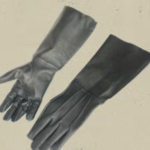 or basic leather one’s will do nicely.
or basic leather one’s will do nicely.
3. “The Spiritual Combat” or “Manual for Spiritual Warfare”. The thing about being a Catholic swordsman is that you are studying Western Martial Arts, not for its own sake, but as the metaphor and training ground for spiritual combat. In that vein, you need a good manual of spiritual warfare.
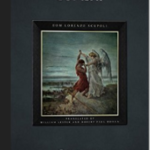 The Spiritual Combat by Dom Lorenzo Scupoli is the book that Saint Ignatius carried with him and that he read every day.
The Spiritual Combat by Dom Lorenzo Scupoli is the book that Saint Ignatius carried with him and that he read every day.
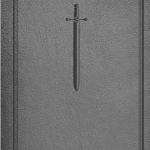 A more modern book, the Manual for Spiritual Warfare by Paul Thigpen is a wonderful companion too.
A more modern book, the Manual for Spiritual Warfare by Paul Thigpen is a wonderful companion too.
4. Training Dagger. Training weapons made of hickory or blunted steel are a critical component of this art. A wooden dagger is a nice additional piece to add to your martial artist’s tools and it has a lower cost than a full sword.
 The Rondel was favored during this period
The Rondel was favored during this period
 but a bladed Gauche would also have been seen.
but a bladed Gauche would also have been seen.
5. “The Knightly Art of the Longsword” or “Codex Wallerstein”. We are studying a sword-based martial art, so having multiple manuals from the Medieval and/or Renaissance is important for a student. These are the best for beginners in the art
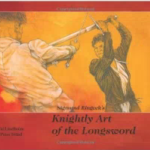 Sigmund Ringneck’s translation is a little dated, but the manual is easy to understand and gives an excellent foundational understanding of the longsword, which is the basis of all western martial arts.
Sigmund Ringneck’s translation is a little dated, but the manual is easy to understand and gives an excellent foundational understanding of the longsword, which is the basis of all western martial arts.
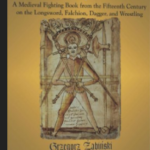 Codex Wallerstein gives another perspective on the longsword as well as adding in wrestling, dagger, and other weapons.
Codex Wallerstein gives another perspective on the longsword as well as adding in wrestling, dagger, and other weapons.
6. Membership to The Order of Lepanto. Just what every Catholic Western martial Artist needs – a 1 year membership to the Order of Lepanto! We are dedicated to faithfully re-creating the martial arts that the knights used during the Medieval and Renaissance periods, along with building the faith of the men involved.
7. Fencing Mask. A key component to learning any martial art is sparring – testing your skills against a real opponent in a friendly setting where both can learn. With sword sparring, a mask is required for safety.
 Luckily there are a couple of affordable options from Absolute Fencing and Blue Gauntlet Fencing.
Luckily there are a couple of affordable options from Absolute Fencing and Blue Gauntlet Fencing.
8. Wooden Waster. The wooden water is a time honored tradition that hearkens back to the Renaissance. Since swords were expensive and one did not want to damage them during training, men would use wooden training weapons that simulated the look and feel of the real thing. We only recommend using impact grade hickory swords. Some of our recommended ones are:
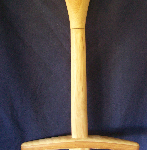 Hollow Earth Swordworks
Hollow Earth Swordworks
Purple Heart Armory
or New Stirling Arms
9. Bob T orso Training Bag. This training tool was developed for unarmed martial arts, but it works quite nicely with a waster or a blunt steel sword.
orso Training Bag. This training tool was developed for unarmed martial arts, but it works quite nicely with a waster or a blunt steel sword.
You can use the BOB to ensure your edge alignment is good and for practicing combinations. If you are handy, you could also build a pell out of a 4×4 post and some other materials – a nice set of instructions can be found here.
10. Steel Sword. The ultimate gift for the budding swordsman in your life! While this is a more pricey piece of equipment, there is nothing like practicing with steel sword. There are a lot of low-quality swords out there that are not designed or built to withstand the rigors of sparring. The one’s listed here are built to withstand the pressures of the fight.
 The Maestro Line from Albion is currently the ultimate in sparring swords. The Meyer and Liechtenauer are the models to looking at.
The Maestro Line from Albion is currently the ultimate in sparring swords. The Meyer and Liechtenauer are the models to looking at.
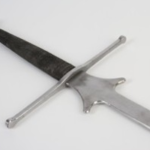 Another good choice is a Feder from Regenyei Armoury. These are good mid-tier swords.
Another good choice is a Feder from Regenyei Armoury. These are good mid-tier swords.
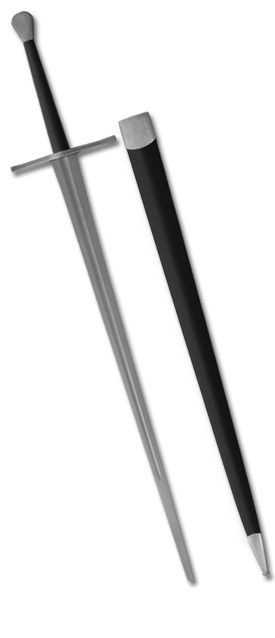 Finally, there is the Tinker-Pearce Longsword from Hanwei. It is a beginners sword with a price to match. This one won’t last as long, but it is a way to spar with a real steel sword.
Finally, there is the Tinker-Pearce Longsword from Hanwei. It is a beginners sword with a price to match. This one won’t last as long, but it is a way to spar with a real steel sword.
Merry Christmas to all!
(updated on 28 Nov 17 to reflect some new options)
 am naturally more receptive to than others. I have, and suspect many of us do, a mixture of good soil, shallow soil, and rocky ground. It occurs to me that I need to discern how I can turn those areas that are barren in my life into more fertile ground for God’s word.
am naturally more receptive to than others. I have, and suspect many of us do, a mixture of good soil, shallow soil, and rocky ground. It occurs to me that I need to discern how I can turn those areas that are barren in my life into more fertile ground for God’s word. “Then he made the disciples get into the boat and precede him to the other side, while he dismissed the crowds. After doing so, he went up on the mountain by himself to pray. When it was evening he was there alone. Meanwhile the boat, already a few miles offshore, was being tossed about by the waves, for the wind was against it. During the fourth watch of the night, he came toward them, walking on the sea. When the disciples saw him walking on the sea they were terrified. “It is a ghost,” they said, and they cried out in fear. At once [Jesus] spoke to them, “Take courage, it is I; do not be afraid.” Peter said to him in reply, “Lord, if it is you, command me to come to you on the water.” He said, “Come.” Peter got out of the boat and began to walk on the water toward Jesus. But when he saw how [strong] the wind was he became frightened; and, beginning to sink, he cried out, “Lord, save me!” Immediately Jesus stretched out his hand and caught him, and said to him, “O you of little faith, why did you doubt?” After they got into the boat, the wind died down. Those who were in the boat did him homage, saying, “Truly, you are the Son of God.” – Matthew 14:22-32
“Then he made the disciples get into the boat and precede him to the other side, while he dismissed the crowds. After doing so, he went up on the mountain by himself to pray. When it was evening he was there alone. Meanwhile the boat, already a few miles offshore, was being tossed about by the waves, for the wind was against it. During the fourth watch of the night, he came toward them, walking on the sea. When the disciples saw him walking on the sea they were terrified. “It is a ghost,” they said, and they cried out in fear. At once [Jesus] spoke to them, “Take courage, it is I; do not be afraid.” Peter said to him in reply, “Lord, if it is you, command me to come to you on the water.” He said, “Come.” Peter got out of the boat and began to walk on the water toward Jesus. But when he saw how [strong] the wind was he became frightened; and, beginning to sink, he cried out, “Lord, save me!” Immediately Jesus stretched out his hand and caught him, and said to him, “O you of little faith, why did you doubt?” After they got into the boat, the wind died down. Those who were in the boat did him homage, saying, “Truly, you are the Son of God.” – Matthew 14:22-32 unheeded. Why? Again, I think it is due to FEAR. They are afraid that it will make them look bad (or in some instances, that they will be caught in their own issues). Perhaps they were afraid that if these things came to light it would undermine the good that came out of the Dallas Charter and the good things that the Catholic Church does in the world. I think some were afraid that the laity would not have their backs, so to speak, if improprieties were known. So some chose to ignore the warnings and now we must suffer a greater loss. Perhaps there was also a fear of being pushed outside of the sphere of academic and political insiders if they stood up for the moral teachings of the Church. I would remind our leaders that the faith is at home with neither political party and being true to the teachings of Jesus can be uncomfortable to talk about. Please resist the temptation to ignore certain principles in order to “get along” with either side of the political spectrum.
unheeded. Why? Again, I think it is due to FEAR. They are afraid that it will make them look bad (or in some instances, that they will be caught in their own issues). Perhaps they were afraid that if these things came to light it would undermine the good that came out of the Dallas Charter and the good things that the Catholic Church does in the world. I think some were afraid that the laity would not have their backs, so to speak, if improprieties were known. So some chose to ignore the warnings and now we must suffer a greater loss. Perhaps there was also a fear of being pushed outside of the sphere of academic and political insiders if they stood up for the moral teachings of the Church. I would remind our leaders that the faith is at home with neither political party and being true to the teachings of Jesus can be uncomfortable to talk about. Please resist the temptation to ignore certain principles in order to “get along” with either side of the political spectrum.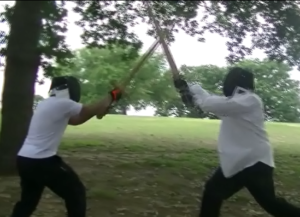 traditions of the historic Knightly Orders through the study and practice of swordsmanship while building character, learning more about our faith, and strengthening our values and bodies. Learning and practicing these self-defense martial arts appeals to a man’s natural desire to protect while also engaging many of the seven heavenly virtues: prudence, justice, temperance, fortitude (courage), faith, hope, and charity (for more on this see our article:
traditions of the historic Knightly Orders through the study and practice of swordsmanship while building character, learning more about our faith, and strengthening our values and bodies. Learning and practicing these self-defense martial arts appeals to a man’s natural desire to protect while also engaging many of the seven heavenly virtues: prudence, justice, temperance, fortitude (courage), faith, hope, and charity (for more on this see our article:  sins, the virtues, and how the virtues counteracted the deadly sins. In recent decades this necessary education seems to have fallen by the wayside. This is an unfortunate development because it is truly important to know. Why? In studying martial arts (or military strategy) we learn that we must be able to both identify the tactics our opponent and our own counters to those actions.
sins, the virtues, and how the virtues counteracted the deadly sins. In recent decades this necessary education seems to have fallen by the wayside. This is an unfortunate development because it is truly important to know. Why? In studying martial arts (or military strategy) we learn that we must be able to both identify the tactics our opponent and our own counters to those actions.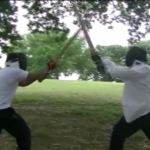 connecting them with the martial tradition of the historic Knightly Orders of the Catholic Church through the study and practice of swordsmanship. We use many medieval and renaissance texts to reconstruct how swords were really used. Through this we connect with our religious heritage while building character, learning more about our faith, and strengthening our values and bodies. A large part of what we do is to teach tactics for physical and spiritual defense. One component of those spiritual tactics are the virtues, both cardinal and theological, which are sometimes referred to as the heavenly or Christian virtues: prudence, justice, temperance, fortitude (courage), faith, hope, and charity.
connecting them with the martial tradition of the historic Knightly Orders of the Catholic Church through the study and practice of swordsmanship. We use many medieval and renaissance texts to reconstruct how swords were really used. Through this we connect with our religious heritage while building character, learning more about our faith, and strengthening our values and bodies. A large part of what we do is to teach tactics for physical and spiritual defense. One component of those spiritual tactics are the virtues, both cardinal and theological, which are sometimes referred to as the heavenly or Christian virtues: prudence, justice, temperance, fortitude (courage), faith, hope, and charity.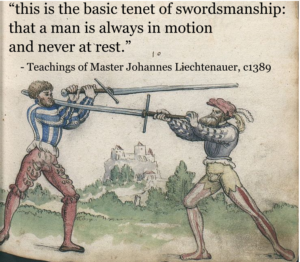 gels. The heart of spiritual combat is to overcome these temptations to sin because giving up on trying to grow your relationship with the Lord is not a viable option if heaven is your goal.
gels. The heart of spiritual combat is to overcome these temptations to sin because giving up on trying to grow your relationship with the Lord is not a viable option if heaven is your goal. A person who has a wooden sword will need to have boiled linseed oil to regularly treat the sword.
A person who has a wooden sword will need to have boiled linseed oil to regularly treat the sword. Oil to prevent rust – you can use a gun oil or a sword oil for this
Oil to prevent rust – you can use a gun oil or a sword oil for this A flat metal file with a medium grit to dress nicks in the edge
A flat metal file with a medium grit to dress nicks in the edge And a way to store the sword when not in use that will protect it from rust. I recommend using a gun sock made for rifles, they are inexpensive and the length is just right.
And a way to store the sword when not in use that will protect it from rust. I recommend using a gun sock made for rifles, they are inexpensive and the length is just right. x gloves by Magid. These gloves offer good protection to all 5 fingers, knuckles, and the back of the hand.
x gloves by Magid. These gloves offer good protection to all 5 fingers, knuckles, and the back of the hand. A set of Original M-Pact gloves from Mechanix. Good protection for 4 fingers and knuckles, okay protection on the thumb and back of hand.
A set of Original M-Pact gloves from Mechanix. Good protection for 4 fingers and knuckles, okay protection on the thumb and back of hand. or basic leather one’s will do nicely.
or basic leather one’s will do nicely. The Spiritual Combat by Dom Lorenzo Scupoli is the book that Saint Ignatius carried with him and that he read every day.
The Spiritual Combat by Dom Lorenzo Scupoli is the book that Saint Ignatius carried with him and that he read every day. A more modern book, the Manual for Spiritual Warfare by Paul Thigpen is a wonderful companion too.
A more modern book, the Manual for Spiritual Warfare by Paul Thigpen is a wonderful companion too. but a bladed Gauche would also have been seen.
but a bladed Gauche would also have been seen. Sigmund Ringneck’s translation is a little dated, but the manual is easy to understand and gives an excellent foundational understanding of the longsword, which is the basis of all western martial arts.
Sigmund Ringneck’s translation is a little dated, but the manual is easy to understand and gives an excellent foundational understanding of the longsword, which is the basis of all western martial arts. Codex Wallerstein gives another perspective on the longsword as well as adding in wrestling, dagger, and other weapons.
Codex Wallerstein gives another perspective on the longsword as well as adding in wrestling, dagger, and other weapons. Luckily there are a couple of affordable options from Absolute Fencing and Blue Gauntlet Fencing.
Luckily there are a couple of affordable options from Absolute Fencing and Blue Gauntlet Fencing.
 orso Training Bag. This training tool was developed for unarmed martial arts, but it works quite nicely with a waster or a blunt steel sword.
orso Training Bag. This training tool was developed for unarmed martial arts, but it works quite nicely with a waster or a blunt steel sword. Another good choice is a Feder from Regenyei Armoury. These are good mid-tier swords.
Another good choice is a Feder from Regenyei Armoury. These are good mid-tier swords. Finally, there is the Tinker-Pearce Longsword from Hanwei. It is a beginners sword with a price to match. This one won’t last as long, but it is a way to spar with a real steel sword.
Finally, there is the Tinker-Pearce Longsword from Hanwei. It is a beginners sword with a price to match. This one won’t last as long, but it is a way to spar with a real steel sword. efore take unto you the armour of God, that you may be able to resist in the evil day, and to stand in all things perfect.
efore take unto you the armour of God, that you may be able to resist in the evil day, and to stand in all things perfect.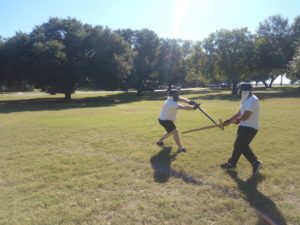 Martial Arts of Renaissance Europe (MARE), which is our group’s specific martial art, you see a similar understanding in other disciplines as well. Sifu Ted Wong from the New York Martial Arts Academy writes, “Footwork allows us to do 3 things: makes us hit harder, puts us in a position to hit, and gets us out of danger.” Even Bruce Lee spoke about the importance of your feet in combat: “The essence of fighting is the art of moving.”
Martial Arts of Renaissance Europe (MARE), which is our group’s specific martial art, you see a similar understanding in other disciplines as well. Sifu Ted Wong from the New York Martial Arts Academy writes, “Footwork allows us to do 3 things: makes us hit harder, puts us in a position to hit, and gets us out of danger.” Even Bruce Lee spoke about the importance of your feet in combat: “The essence of fighting is the art of moving.”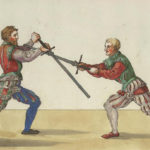 Cod.HS.3227a codex Hanko Dobringer writes this, “Before [Vor], After[Nach], Weak [Weich], Strong [Hart], in that instant/just as [Indes]. On these words hinge the whole art of Liechtenauer, and they are the foundation and cornerstone of all fencing on foot or on horseback, in armour [Harnusche] or without [Blos].” So the words are Before, After, Weak, Strong, and In the instant/moment.
Cod.HS.3227a codex Hanko Dobringer writes this, “Before [Vor], After[Nach], Weak [Weich], Strong [Hart], in that instant/just as [Indes]. On these words hinge the whole art of Liechtenauer, and they are the foundation and cornerstone of all fencing on foot or on horseback, in armour [Harnusche] or without [Blos].” So the words are Before, After, Weak, Strong, and In the instant/moment.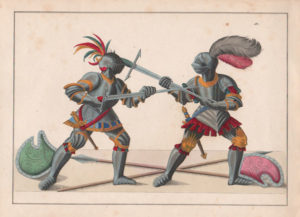 martial arts distilled down to five words. These base concepts span all of martial arts history and are as true today as they were in the 1300s. Okay, that’s great. If I get in a fight I know to use these as the basis of my strategic and tactical thinking, but how do these words have any relation to my life in general? Well, let’s look at this in light of our everyday life and then we will get into how we can use these words as the basis of our faith walk.
martial arts distilled down to five words. These base concepts span all of martial arts history and are as true today as they were in the 1300s. Okay, that’s great. If I get in a fight I know to use these as the basis of my strategic and tactical thinking, but how do these words have any relation to my life in general? Well, let’s look at this in light of our everyday life and then we will get into how we can use these words as the basis of our faith walk. the Christian worldview, we began to reduce the chances for life-threatening adversity and this resulted in a much better society overall. We cured more sicknesses, fed more people, and lowered infant mortality which helped to make the bare essential parts of life possible for a great number of people. The challenges then became advancing from subsistence to abundance. It can be argued that in modern society we are now providing more than subsistence and have encroached into satisfactory. While no one would argue that welfare is abundance, the level it does provide along with the way it is structured makes it easier just to stay at that level instead of becoming self-sufficient. Without that challenge of needing to lead and provide for a family, we have made couch potatoes. The Catholic Church, likewise, has responded to the reduction of challenges in our society by making it easier – the fast before receiving Holy Communion has been reduced to a bare minimum, Holy Days of Obligation are moved to Sunday so people don’t have to go Mass more than once per week, penance on Fridays has been downplayed until it has been all but obliterated, and the examples could go on. The central idea was that in making it easier to be Catholic, more people would choose to be in the faith. However, the reality is something quite different. Without the challenges presented by trying to live the traditional faith, people became spiritual couch potatoes. Jesus, who knows a thing or two about human nature, put out some amazing challenges for the faithful:
the Christian worldview, we began to reduce the chances for life-threatening adversity and this resulted in a much better society overall. We cured more sicknesses, fed more people, and lowered infant mortality which helped to make the bare essential parts of life possible for a great number of people. The challenges then became advancing from subsistence to abundance. It can be argued that in modern society we are now providing more than subsistence and have encroached into satisfactory. While no one would argue that welfare is abundance, the level it does provide along with the way it is structured makes it easier just to stay at that level instead of becoming self-sufficient. Without that challenge of needing to lead and provide for a family, we have made couch potatoes. The Catholic Church, likewise, has responded to the reduction of challenges in our society by making it easier – the fast before receiving Holy Communion has been reduced to a bare minimum, Holy Days of Obligation are moved to Sunday so people don’t have to go Mass more than once per week, penance on Fridays has been downplayed until it has been all but obliterated, and the examples could go on. The central idea was that in making it easier to be Catholic, more people would choose to be in the faith. However, the reality is something quite different. Without the challenges presented by trying to live the traditional faith, people became spiritual couch potatoes. Jesus, who knows a thing or two about human nature, put out some amazing challenges for the faithful: As part of my studies of the martial arts of Medieval and Renaissance Europe, I specifically looked at the history of knights, especially those of the Catholic Military Orders (e.g. The Knights of Saint John/Malta/Hospitaller, Teutonic Knights, etc.). In the course of that reading, I came across an article from Patrick Meehan, published at the Medievalists.net website in 2014. The author writes about the history of knights and how the actions of these historical figures runs the gamut from violent and destructive to the courtesies of courtly life. The author goes on to discuss the happenings in the lives of 3 different knights – an anonymous knight in the Teutonic Knights, Ulrich von Lichtenstein, and Jӧrg von Ehingen. The lives of these three men were distinctly different and spanned 200 years of history, but there was a common thread that linked them together and linked them to us – and the key to understanding that linkage lies in the Theology of the Body.
As part of my studies of the martial arts of Medieval and Renaissance Europe, I specifically looked at the history of knights, especially those of the Catholic Military Orders (e.g. The Knights of Saint John/Malta/Hospitaller, Teutonic Knights, etc.). In the course of that reading, I came across an article from Patrick Meehan, published at the Medievalists.net website in 2014. The author writes about the history of knights and how the actions of these historical figures runs the gamut from violent and destructive to the courtesies of courtly life. The author goes on to discuss the happenings in the lives of 3 different knights – an anonymous knight in the Teutonic Knights, Ulrich von Lichtenstein, and Jӧrg von Ehingen. The lives of these three men were distinctly different and spanned 200 years of history, but there was a common thread that linked them together and linked them to us – and the key to understanding that linkage lies in the Theology of the Body. Matrimony. God’s love has four components – it must be free, total, faithful, and fruitful. So to, should the love between spouses exhibit these four elements and marriages suffer when they are absent. First is freedom – we must be free to marry our spouse. Which means not only that we are not married to another, but also that we are not forcing our spouse to do something and we are able to forsake relations with all others. Next is total, the love must be total and one spouse should not say “I give you everything, except…” Totality also includes forever, which is why a prenuptial agreement is an impediment to a sacramental marriage as it presupposes failure and you have not committed to give your spouse your entire future. Faithfulness is third on the list and it should be clear, at least on the physical level, of the importance of faithfulness. This also refers to faithfulness in word and in thought – engaging in fantasies about others is unfaithful too. And finally fruitful, which describes how physical relations between spouses need to be open to life, though not necessarily timed to generate a life. This vision of spousal love is a total gift of self to the vocation of marriage – our work, our play, and our faith life are centered on our spouse and any children that arise from this union.
Matrimony. God’s love has four components – it must be free, total, faithful, and fruitful. So to, should the love between spouses exhibit these four elements and marriages suffer when they are absent. First is freedom – we must be free to marry our spouse. Which means not only that we are not married to another, but also that we are not forcing our spouse to do something and we are able to forsake relations with all others. Next is total, the love must be total and one spouse should not say “I give you everything, except…” Totality also includes forever, which is why a prenuptial agreement is an impediment to a sacramental marriage as it presupposes failure and you have not committed to give your spouse your entire future. Faithfulness is third on the list and it should be clear, at least on the physical level, of the importance of faithfulness. This also refers to faithfulness in word and in thought – engaging in fantasies about others is unfaithful too. And finally fruitful, which describes how physical relations between spouses need to be open to life, though not necessarily timed to generate a life. This vision of spousal love is a total gift of self to the vocation of marriage – our work, our play, and our faith life are centered on our spouse and any children that arise from this union.